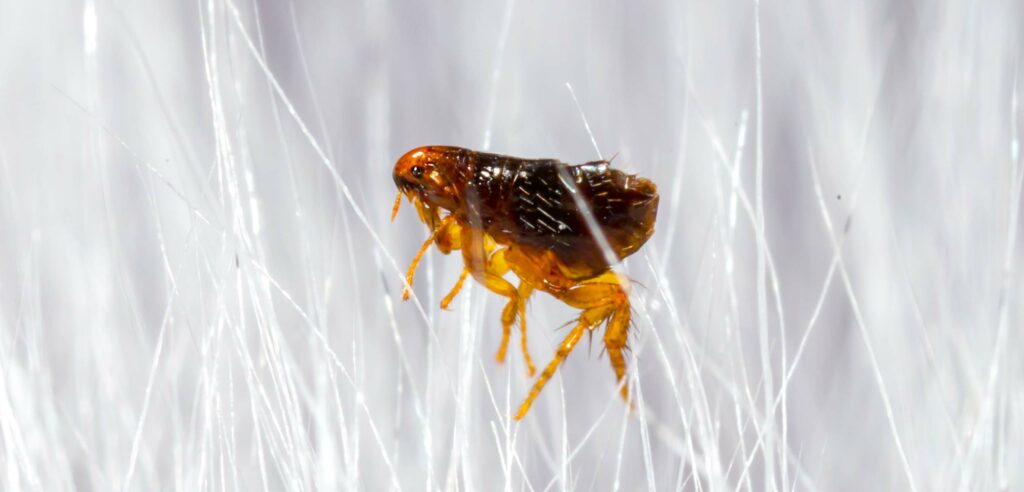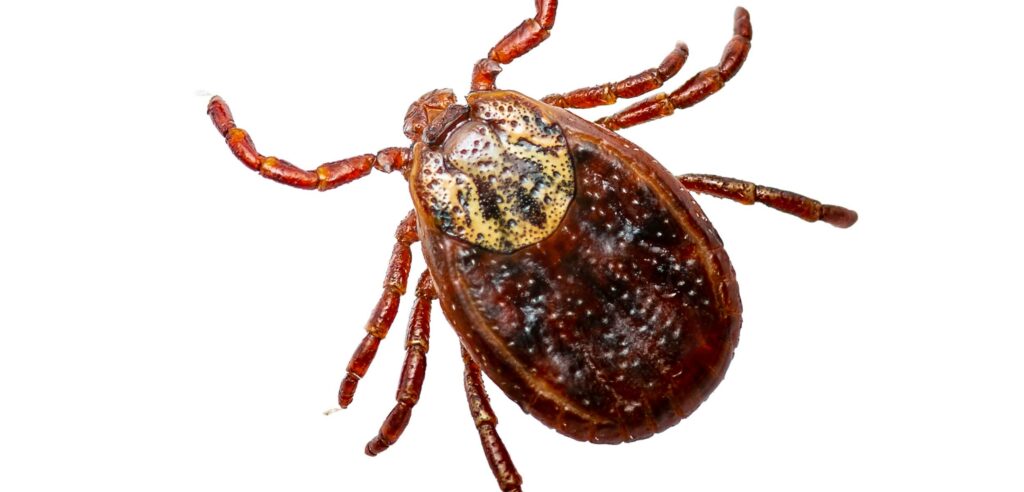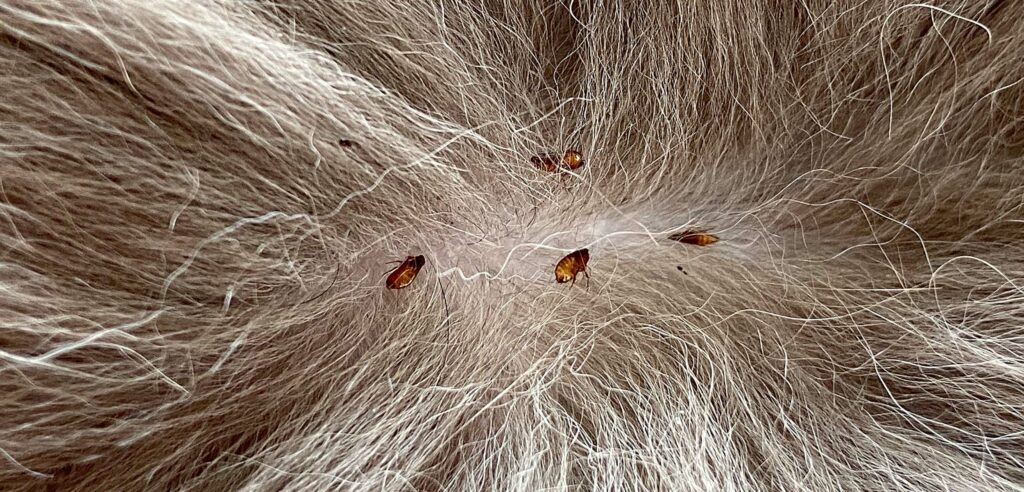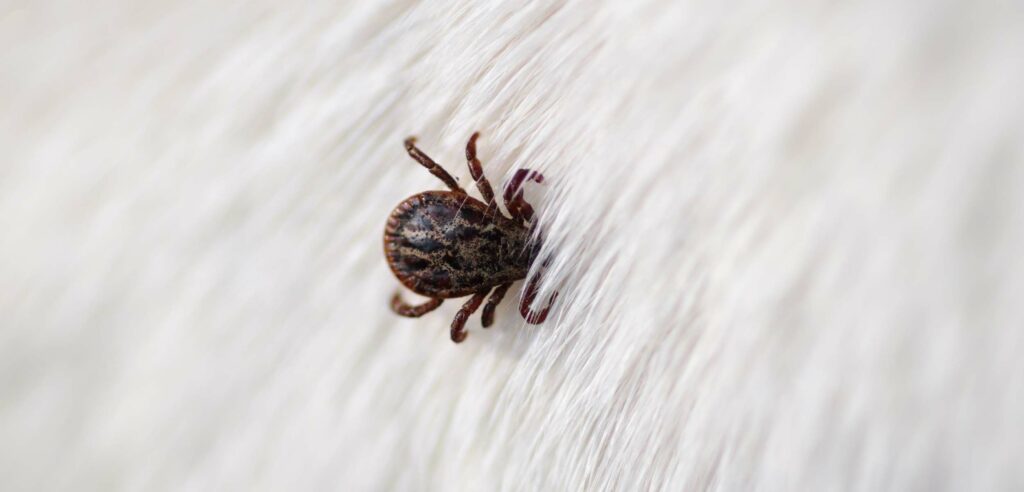Who doesn’t love spending lazy days outdoors with your furry friend?! But while you’re enjoying the warmer weather, be aware of the dangers that fleas and ticks pose to your dog. These pesky pests not only cause your dog discomfort but can also transmit dangerous diseases.
Fortunately, you can take a few simple steps to protect your dog from fleas and ticks. Here’s what you need to know.
What Are Fleas & Ticks?
Fleas and ticks are both external parasitic pests. They usually dwell outdoors and prey on dogs and other mammals. Each of these creatures is different, but they have similar detriments to your doggy.
Fleas and ticks are bugs that attach to your pet to use their blood as an energy source.

Fleas
Fleas are small, wingless insects that feed on the blood of animals. They are dark brown in color and have a flat, streamlined body that makes it easy for them to move through fur. Fleas are most active in warm weather and can jump up to 18 inches high, making it easy for them to transfer from one host to another.
Fleas typically live outdoors in shady, humid areas, like under porches or in tall grass. Indoors, they often take up residence in carpets, upholstered furniture, or bedding.

Ticks
Ticks are small, spider-like creatures (arachnids) that attach themselves to animals to feed on their blood. Ticks are usually brown or black in color and vary in size depending on the type of tick and how long they’ve been feeding. Ticks are most active in spring and fall but can be a problem year-round in warmer climates.
Ticks prefer to live in areas with tall grass, bushes, and trees. They are often found in wooded or forested areas. Be conscious of ticks if you enjoy taking your dog for walks in forests or parks.

How Do I Know If My Dog Has Fleas?
One of the easiest ways to tell if your dog has fleas is by looking for flea dirt. Flea dirt is actually the dried blood that fleas excrete after feeding, and it appears as tiny black specks on your dog’s fur.
If you’re not sure what you’re seeing is flea dirt, try placing a white piece of paper underneath your dog and combing through their fur with a fine-toothed comb. If the specks turn red, then you know it’s flea dirt.

Does My Dog Have Ticks?
Ticks are usually easier to spot than fleas since they are larger and attach themselves to the skin. They are often most commonly seen around the head, neck, and ears, but ticks can be found anywhere on your dog’s body. If you find a tick on your dog, it’s essential to remove it immediately (more on that below).
Are Fleas & Ticks Dangerous to Dogs?
Fleas and ticks can both pose a serious threat to your dog’s health. Fleas can cause flea allergy dermatitis, which is an allergic reaction to the flea bite. This can lead to severe itching, hair loss, and even secondary infections.
Ticks can transmit a number of different diseases to dogs, including Lyme disease, Rocky Mountain spotted fever, and ehrlichiosis. These diseases can cause a wide range of symptoms, from mild to deadly. That’s why it’s so important to prevent fleas and ticks on your dog and to remove them promptly if they are found.

How Do I Protect My Dog from Fleas & Ticks?
There are several store-bought products available to help protect your dog from fleas and ticks. These include spot-on treatments, oral medications, shampoos, collars, and sprays.
Be sure to talk to your veterinarian about which option is best for your dog based on their individual needs and health.
In addition to using a preventative product, there are a few simple things you can do to help keep fleas and ticks away from your dog.
Keep your yard pruned and free of debris where fleas and ticks can hide.
Both ticks and fleas like living in areas with lots of foliage. Long grass, in particular, is a favorite hiding spot for these pests. Try keeping your grass mowed and trees pruned in your yard.
If your dog has a favorite play area and your region is prone to fleas, consider cutting back bushes and shrubs.
Avoid areas where fleas and ticks are known to be present.
Some woodland areas are recognized as tick hot-zones. Be extra vigilant in these areas after walks and runs with your dog. Consider changing your route if your dog constantly gets fleas from certain parks or fields.
Check your dog for fleas and ticks after they’ve been in contact with other animals or outdoors.
Fleas can jump up to 18 inches! So one dog with fleas makes all the canines it encounters more vulnerable. These pests can bother a whole pack of dogs when given the opportunity.
Ticks continue to feed on your dog’s blood until they are removed. So check for these pests after your dog has been in any area known for being a tick risk.
Have your property regularly treated for fleas and ticks.
Professional flea and tick treatment is always going to lower the threat of these parasites sinking their teeth into your pets. Treatments stave off these pests and are totally safe for dogs, cats, and other common pets.
Depending on your region and property, this may need to be done several times a year.
Keep your dog’s fur short in the summer to help prevent fleas and ticks from attaching.
Let’s be clear—both long and short-haired dogs can get fleas or ticks. But keeping your canine’s hair shorter makes managing these pet pests easier.
Longer hair makes it more difficult for dogs to scratch-off bugs themselves. And it makes it harder for you to identify fleas or ticks once they’ve invaded your pet.

How to Remove Fleas from Your Dog
If you do find ticks or fleas on your dog, it’s important to remove them properly. For fleas, use a fine-toothed comb to remove them from your dog’s fur. Brush thoroughly until all the insects are removed.
Be sure to dispose of the fleas afterward so they can’t jump back onto your dog. Place the fleas in a sealed plastic bag in the trash. Do not simply brush fleas onto the grass or ground.
Fleas may bite a human but do not usually pose any serious threats. Wear gloves when grooming your dog for added protection.

How to Remove Ticks from Your Dog
To remove a tick, use tweezers to grasp the tick by the head and pull gently until it releases its grip. Be sure not to squeeze the tick’s body, as this can cause the contents to be released into your dog’s skin.
Once the tick is removed, disinfect the area and dispose of the tick in a sealed container. Rubbing alcohol or soap and water is sufficient for disinfecting your pup.
Tick bites are also usually harmless to humans.

Be Your Dog’s Best Friend
Following these simple tips can help keep your dog safe from fleas and ticks all year long. But another way you can be your dog’s best friend is by getting rid of ticks and fleas from your yard and property with professional services.
By keeping fleas out of your home and your yard, you’ll know your dog can run free without stressing about these pests jumping along for the ride.
Dustin Pest Control specializes in flea and tick removal for homeowners across California. All of our pest control services are 100% pet-friendly (more information here). Give us a call to keep your canines happy and flea-free all summer long!


